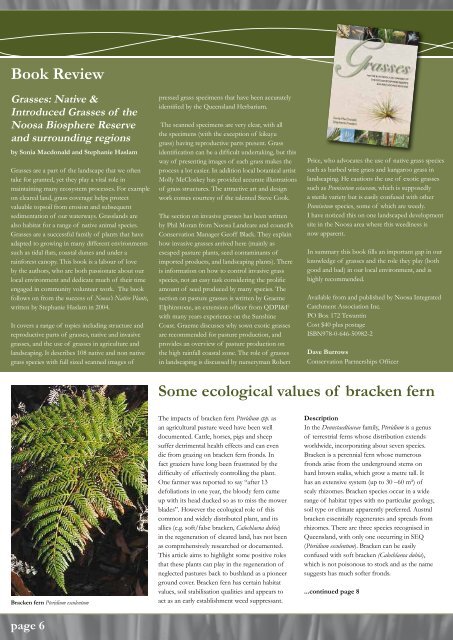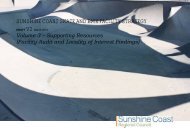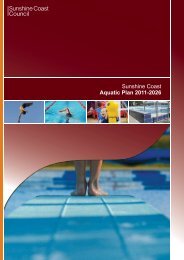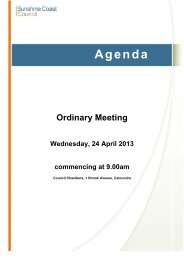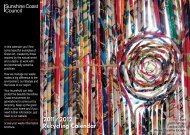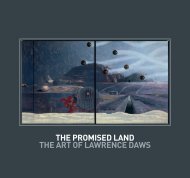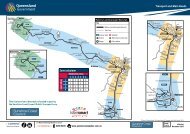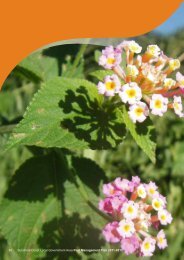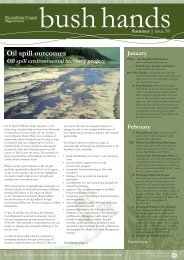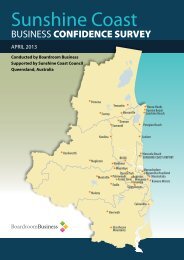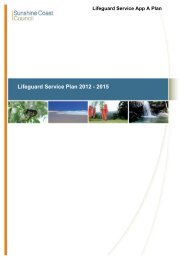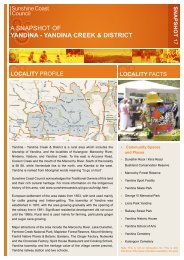Sunshine Coast Conservation Forum - Sunshine Coast Council
Sunshine Coast Conservation Forum - Sunshine Coast Council
Sunshine Coast Conservation Forum - Sunshine Coast Council
You also want an ePaper? Increase the reach of your titles
YUMPU automatically turns print PDFs into web optimized ePapers that Google loves.
Book Review<br />
Grasses: Native &<br />
Introduced Grasses of the<br />
Noosa Biosphere Reserve<br />
and surrounding regions<br />
by Sonia Macdonald and Stephanie Haslam<br />
Grasses are a part of the landscape that we often<br />
take for granted, yet they play a vital role in<br />
maintaining many ecosystem processes. For example<br />
on cleared land, grass coverage helps protect<br />
valuable topsoil from erosion and subsequent<br />
sedimentation of our waterways. Grasslands are<br />
also habitat for a range of native animal species.<br />
Grasses are a successful family of plants that have<br />
adapted to growing in many different environments<br />
such as tidal flats, coastal dunes and under a<br />
rainforest canopy. This book is a labour of love<br />
by the authors, who are both passionate about our<br />
local environment and dedicate much of their time<br />
engaged in community volunteer work. The book<br />
follows on from the success of Noosa’s Native Plants,<br />
written by Stephanie Haslam in 2004.<br />
It covers a range of topics including structure and<br />
reproductive parts of grasses, native and invasive<br />
grasses, and the use of grasses in agriculture and<br />
landscaping. It describes 108 native and non native<br />
grass species with full sized scanned images of<br />
pressed grass specimens that have been accurately<br />
identified by the Queensland Herbarium.<br />
The scanned specimens are very clear, with all<br />
the specimens (with the exception of kikuyu<br />
grass) having reproductive parts present. Grass<br />
identification can be a difficult undertaking, but this<br />
way of presenting images of each grass makes the<br />
process a lot easier. In addition local botanical artist<br />
Molly McCloskey has provided accurate illustrations<br />
of grass structures. The attractive art and design<br />
work comes courtesy of the talented Steve Cook.<br />
The section on invasive grasses has been written<br />
by Phil Moran from Noosa Landcare and council’s<br />
<strong>Conservation</strong> Manager Geoff Black. They explain<br />
how invasive grasses arrived here (mainly as<br />
escaped pasture plants, seed contaminants of<br />
imported products, and landscaping plants). There<br />
is information on how to control invasive grass<br />
species, not an easy task considering the prolific<br />
amount of seed produced by many species. The<br />
section on pasture grasses is written by Graeme<br />
Elphinstone, an extension officer from QDPI&F<br />
with many years experience on the <strong>Sunshine</strong><br />
<strong>Coast</strong>. Graeme discusses why sown exotic grasses<br />
are recommended for pasture production, and<br />
provides an overview of pasture production on<br />
the high rainfall coastal zone. The role of grasses<br />
in landscaping is discussed by nurseryman Robert<br />
Price, who advocates the use of native grass species<br />
such as barbed wire grass and kangaroo grass in<br />
landscaping. He cautions the use of exotic grasses<br />
such as Pennisetum setaceum, which is supposedly<br />
a sterile variety but is easily confused with other<br />
Pennisetum species, some of which are weedy.<br />
I have noticed this on one landscaped development<br />
site in the Noosa area where this weediness is<br />
now apparent.<br />
In summary this book fills an important gap in our<br />
knowledge of grasses and the role they play (both<br />
good and bad) in our local environment, and is<br />
highly recommended.<br />
Available from and published by Noosa Integrated<br />
Catchment Association Inc.<br />
PO Box 172 Tewantin<br />
Cost $40 plus postage<br />
ISBN978-0-646-50982-2<br />
Dave Burrows<br />
<strong>Conservation</strong> Partnerships Officer<br />
Some ecological values of bracken fern<br />
Bracken fern Pteridium esculentum<br />
page 6<br />
The impacts of bracken fern Pteridium spp. as<br />
an agricultural pasture weed have been well<br />
documented. Cattle, horses, pigs and sheep<br />
suffer detrimental health effects and can even<br />
die from grazing on bracken fern fronds. In<br />
fact graziers have long been frustrated by the<br />
difficulty of effectively controlling the plant.<br />
One farmer was reported to say “after 13<br />
defoliations in one year, the bloody fern came<br />
up with its head ducked so as to miss the mower<br />
blades”. However the ecological role of this<br />
common and widely distributed plant, and its<br />
allies (e.g. soft/false bracken, Calochlaena dubia)<br />
in the regeneration of cleared land, has not been<br />
as comprehensively researched or documented.<br />
This article aims to highlight some positive roles<br />
that these plants can play in the regeneration of<br />
neglected pastures back to bushland as a pioneer<br />
ground cover. Bracken fern has certain habitat<br />
values, soil stabilisation qualities and appears to<br />
act as an early establishment weed suppressant.<br />
Description<br />
In the Dennstaedtiaceae family, Pteridium is a genus<br />
of terrestrial ferns whose distribution extends<br />
worldwide, incorporating about seven species.<br />
Bracken is a perennial fern whose numerous<br />
fronds arise from the underground stems on<br />
hard brown stalks, which grow a metre tall. It<br />
has an extensive system (up to 30 –60 m²) of<br />
scaly rhizomes. Bracken species occur in a wide<br />
range of habitat types with no particular geology,<br />
soil type or climate apparently preferred. Austral<br />
bracken essentially regenerates and spreads from<br />
rhizomes. There are three species recognised in<br />
Queensland, with only one occurring in SEQ<br />
(Pteridium esculentum). Bracken can be easily<br />
confused with soft bracken (Calochlaena dubia),<br />
which is not poisonous to stock and as the name<br />
suggests has much softer fronds.<br />
...continued page 8


